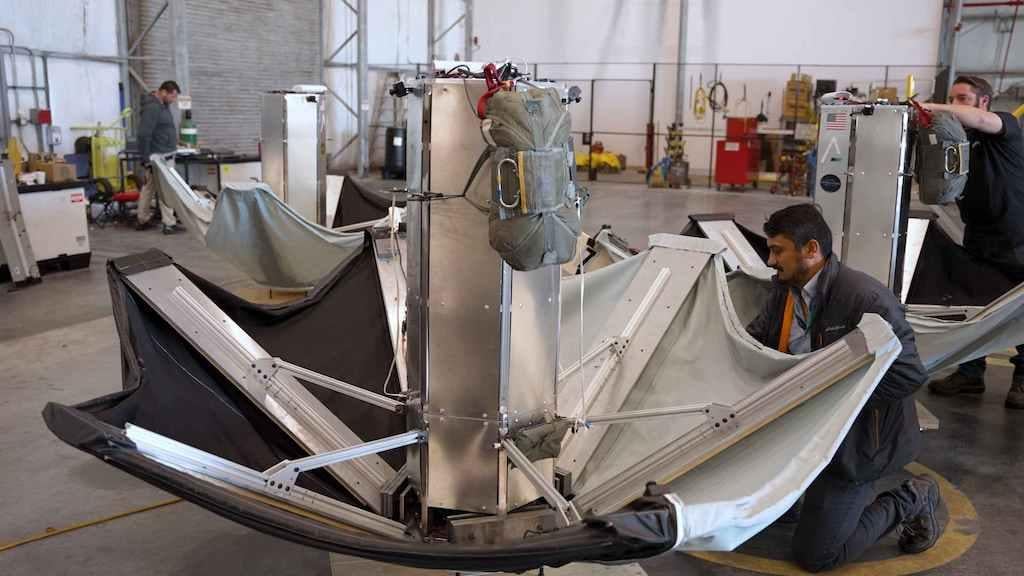This article is published in Aviation Week & Space Technology and is free to read until May 08, 2024. If you want to read more articles from this publication, please click the link to subscribe.

Ghost is a deployable decelerator designed to protect a pre-staged payload during reentry.
Just three years after spinning off from Sierra Nevada, Colorado-based Sierra Space has become a full-fledged defense prime, with its national security space business surging and Dream Chaser spaceplane set for flight. CEO Tom Vice talks to Guy Norris about the company’s growth plans.
AW&ST: How did you develop Sierra Space’s strategy for national security space? We kept in stealth mode and started to put together the strategy in 2021, and then built out the team through 2022. We started to derisk the technology and were able to take advantage of a lot of the spacecraft component businesses that we had. Then we started to inject technology and funding into those. We started quietly building our capability and kept silent about several wins we had through mid-2023 until the SDA [Space Development Agency] contract [for Tranche 2 Tracking Layer missile-tracking satellites] was awarded in January 2024. So, we were forced into the public spotlight—otherwise we would have stayed stealth for probably a little while longer.

What other space defense work have you won? We’ve got a number of prime contracts, and we’ve been winning head-to-head competitions against what I call the four big aerospace and defense primes: Boeing, Lockheed Martin, Northrop Grumman and Raytheon—plus L3Harris. We feel good about those prime contracts—all of which, apart from the SDA one, are classified, so we can’t get into those. But contracts like the SDA one are a really important win for us because it is part of the overall strategy to look at space superiority and space situational awareness. So now we’ve got $1.3 billion of prime contract backlog.
What’s driving your strategy? Our nation’s adversaries are getting more aggressive around the world, and they’re investing a significant amount of money into systems that put things at risk. At the same time, I read about some of the aerospace and defense primes pushing back on the U.S. government on what I see as very innovative new approaches to acquisition that really are focused on putting new capabilities and new affordable systems on orbit at a higher rate of speed. So, we’ve been focusing our technology and our approach to make sure that we’re building out systems and putting them on orbit at the pace which the nation needs. We bring a lot of things to the game. We live each day in a fixed-price mindset; that’s just how you have to live in the commercial world. You have to be really good at risk management, and we’re vertically integrated to have less dependency on the supply chain.
Describe the idea behind Axelerator, your newly launched innovation incubator arm. It was formed as part of Sierra Space’s Orbital Missions and Services group, a national security unit that was founded in 2023. It’s my firm belief that we’ve got to speed up the industry. We’ve got to bring in more people to think about the fact that national security is so important. If we don’t really start to invest and move faster, our adversaries are going to out-invest us. I think every space tech company needs to apply their ingenuity to defense. If we’re going to build a vibrant space economy, we’ve got to make sure that it’s protected and remains free. The Axelerator incubator is meant to be the modern equivalent of the innovators of the past like Jack Northrop, Ben Rich and the Loughead brothers.
Describe some of the products you’ve announced coming out of Axelerator. There are three big projects as part of that. The first is a reentry vehicle dubbed Ghost, which utilizes a deployable hypersonic decelerator system to return objects from space. We’ve already done some aerodynamic flight tests, and it will shortly be in space. The second is Spectre, which I think is incredible differentiating technology for a satellite designed for precision rendezvous and proximity operations (RPO). Third is Sierra Black OS, an AI-enabled operating system for autonomous space operations. The prototype Spectre is due for launch in late 2025, while the first release of Sierra Black OS is called STAR, Sierra Toolkit for Autonomous Rendezvous, and consists of an RPO software module.
What’s so special about Sierra Black OS? There’s so much discussion around AI right now, and we built our entire sphere of Black OS with machine learning integrated. What’s nice about the Sierra Black OS is it has an equivalency of Sierra OS on the commercial side, so there are classified modules that get layered onto that kernel for the classified side. A big module of that is being released as part of Spectre as well [STAR], so not only does it have machine learning and the kernel, but all our hardware will ride on that single OS. So, we have the entire domain linked together. It allows us to do everything from detection and classification to fire control and neutralization.
What’s happening with the Dream Chaser Tenacity spaceplane? It’s now on the cusp of commercial operations with NASA for cargo resupply. But it goes even beyond that. For example, we have a partnership with Japan Airlines, Oita Prefecture and Kanematsu to investigate Oita Airport in Kunisaki, Japan, as a potential Asian landing site—so it’s really thinking about integrating air and space differently. It’s hard to talk about while you’re still in the middle of a bunch of development. You have got to go prove it. But I think we’re getting really close to that now.
What about Dream Chaser’s progress toward launch? We’ll come out of thermal vacuum testing at the NASA Armstrong In-Space Propulsion Facility in Sandusky, Ohio, in the April time frame. Then we’ll put it on the truck and get it down to Kennedy Space Center, where we’ve got some additional testing including electromagnetic interference and acoustic evaluation. And of course, because we’re building a spaceplane we have got to do taxi and tow tests. Then we’ve to get it on a rocket, get cargo in it and get it launched later this year—probably in the second or third quarter. I think we’re lining up for the back half of the summer—sometime in there.
What about the second spaceplane? We call it Reverence. It’s in production now and will enter operations at the end of 2025. We’re coming down the learning curve fast, and right now it’s half the cost of DC-100, the version one.
How important is vertical integration in cutting that cost? We continue to accelerate that. But the beauty about that is when we decide that we’re going to vertically integrate, it’s not only to design it so that we bring the cost way down—we simplify the part. Then we turn right around and we sell that part to the industry again. For example, on the thermal protection system we brought in the ability to manufacture those tiles. They’re cheaper [and] more resilient, and they operate at higher temperatures—and we just had our first commercial sale. We’re doing that with thrusters and avionics and other parts. The strategy really is if you look at a spaceplane, a space station or a satellite, they’re all composed of 13 subsystems. We are now building seven out of those 13 and we’ve kicked off two more, so by the end of this year we’ll have nine out of 13. So you can see how fast we’ve vertically integrated.
What is the status of the inflatable LIFE habitat program? We have had six tests in a row, all 100% successful and all exceeding NASA’s requirements in terms of expandable soft goods structures. The last one was a full-size space station—the size of the station we intend to put up. We took it to full pressure and then ultimately to full burst pressure. NASA’s requirement is four times safety factor, and we exceeded that safety factor by 27%. This year we will have a number of tests, and we’ll take them to full destruction. The [International Space Station] (ISS) took 40 launches to put up. Today, even inside of a short-length Vulcan, we can put up one-third of the ISS. So typically, we could put up the entire volume of the ISS in three launches. Using the same technology utilizing the SpaceX Starship as the rocket, we can put up in a single launch a structure six times bigger than the ISS.





